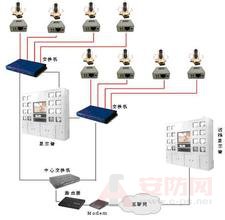
The second generation video surveillance system is a video surveillance system with digital hard disk video recording equipment as its core. The front end of the digital hard disk recorder uses an analog camera, and the back end uses digital signal control and hard disk as the storage medium. The information retrieval and query is convenient and the control is flexible. It is the main mode of video surveillance and has been widely applied and developed. Since the system network structure is a single-function, one-way, centralized information collection network and media-specific features, the system has developed to a very high level relative to its own technical limits, and there is no much potential to dig. And its limitations still exist, to meet higher requirements, digital is the only way.
The third generation video surveillance system - digital network video surveillance system. The key equipment of digital network video surveillance system is video server and network camera. It adopts embedded real-time multi-tasking operating system. The video signal sent by the camera is compressed and encoded by high-efficiency compression chip, and sent to the network interface through the internal bus to be sent to the network. Users on the network can directly use the browser to view images taken by the camera transmitted by the video server on the PC. Authorized users can also control the action of the camera lens and the pan/tilt or configure the system through the video server through the computer network.
Video monitoring "brains"
IP cameras in small business front-end monitoring send information back to the central recording device, which forms the "brain" of the entire system. In this way, it makes sense to lock these locks in a safe place. Even if the thief breaks into the door, you can't steal these things and your evidence.
There are usually two types of recording devices: IP VMS (Video Management Software) running on a standard PC and a dedicated NVR (Network Video Recorder). IP VMS, such as Milestone's XProtect Professional, typically provides an open platform that is scalable and configurable to fit the needs of the customer.
If your customers (or yourself) feel that running software on a non-dedicated PC platform is too complicated and that some of the necessary management of the hardware used is too cumbersome, then you can try D-Link's NVR. The DNS-726-4 is a professional device with two hard drive storage spaces for saving video data, up to 4 cameras, and the company's NVR software can connect up to 4 devices, so the center can be up to Support for 16 cameras.
No matter which method you choose, you must ensure that the software supports all of your customers' needs. Take a look at some of these features, such as event-triggered recording. Mobile trigger recording is more suitable for storage rooms. In this environment, the screen needs to be recorded only when someone enters the space. Some of the more useful features are: email and SMS notifications for suspicious events, remote browsing access (business owners can watch live surveillance videos while in the dead of night or on the road), and smart search.
SPAR120
Solid-phase synthesis, as the key process in the production of Bio-pharmaceuticals, is widely used for the synthesis of deoxyribonucleic acid (DNA), peptides, and so on. The synthesis method is to bound the functional group such as methyl, aminomethyl on a bead, which primiarly is polystyrene microsphere with low crosslink. By the benefits of the monodisperse characteristic, the beads have same particle size and crosslink degree with each other, to ensure the consistent swelling properties.
Resins For Solid Phase Synthesis Spar120
Resins For Solid Phase Synthesis Spar120,Alternative Am Resin,Monodisperse Resins For Solid Phase Synthesis,Spar120 Solid-Phase Synthetic Resin
Nanjing Genshine Bio-technology Co., Ltd , http://www.genshine-bio.com